Dimensions, That Is.
You look at a photograph, you look at a photograph. Unless the photographer is deliberately messing with your head, what’s in the photo is usually pretty obvious, right?
Not so fast! Allan Sekula had an interesting story about that. As he told it,* the anthropologist, Melville Herskovits, while carrying out research in Africa, once showed to a Bush woman a photograph of her son (presumably in black and white). The woman looked at it but saw no image there. He had to point out the details of the picture to her before she was able to make out the recognisable figure of her son.
I’ve thought about that story many times. Sekula says that the photo is ‘unmarked as a message, is a non-message, until it is framed linguistically by the anthropologist’: the mother would, after all, have been completely unfamiliar with the practice of cramming three dimensions into two on a piece of card. The fact that the photo was in black and white must complicate matters a bit, too. So, even a standard photo is not part of some universal language: you have to learn to see what is in it. That isn’t the same as learning to interpret it: it means you have to learn to see that it is meant to replicate a little bit of the external world out there. Since, in the western world, we have been looking at photos for nearly 200 years now it’s second nature to us. But it’s good to remind ourselves that looking at a photo is as much a decoding as is looking at a page of text. Just as the word ‘dog’ is simply a random set of black marks on white paper that represents to Anglophones (who can read) a furry four-legged animal that barks, so a photograph is an otherwise random selection of forms that represents reality for those who know how to look.
Here is one from my Are You Sure You Turned The Gas Off? series. See the face in it? Hint: it’s wearing glasses. Always makes me laugh, this one.
*(Allan Sekula: On The Invention of Photographic Meaning in Thinking Photography, ed. Victor Burgin, 1982, Macmillan)
